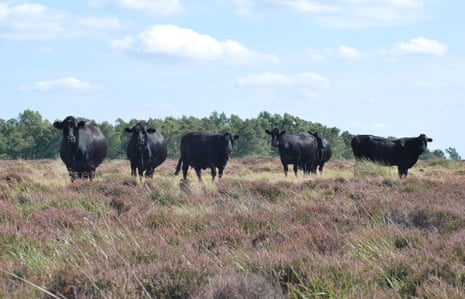Top Stories
Cattle Transform Moorland Ecology as Goldfinches Soar Above

A flock of goldfinches recently took flight over an exposed moor in Derbyshire, demonstrating the region’s vibrant wildlife. The sight of at least 15 goldfinches, elegantly maneuvering through the air, highlighted the ongoing ecological restoration efforts on the moor. Below them, a small herd of cattle, comprising red polls and Welsh blacks, worked diligently to reshape the landscape, contributing to the restoration of its ecology.
Historically dominated by sheep, the moorland’s vegetation has been transformed through a conservation grazing initiative. Sheep tend to graze differently, nibbling plants down to their roots while avoiding tougher grasses. In contrast, cattle utilize their long tongues to uproot moor grass, and their hooves break the surface of the soil. This process allows seeds to take root, thereby enhancing biodiversity in the region.
According to the Eastern Moors Partnership, the introduction of cattle has significantly improved local wildlife populations. Notably, the number of whinchats—small birds typically found in grassy areas—has nearly tripled in the five years since cattle were introduced to the moor. This success emphasizes the vital role of diverse grazing techniques in ecological restoration.
On weekends, the moor attracts a multitude of walkers, some of whom may feel apprehensive around cattle, while others see an opportunity for photographs. To ensure safety, the partnership advises maintaining a distance of at least five metres from the animals. Although the red poll and Welsh black breeds may not capture as much attention as their Highland counterparts, they play an essential role in maintaining the moor’s health.
Plans are emerging in other parts of Derbyshire to explore the potential of using elk in similar ecological restoration efforts. This initiative could further enhance the region’s appeal, particularly among social media enthusiasts eager to share unique wildlife experiences.
As the cattle continue their work, they embody a commitment to ecological health on the moor. Their role is critical, as they quietly uphold the balance of the ecosystem while goldfinches and other wildlife thrive above them. Through ongoing efforts by organizations like the Eastern Moors Partnership, the moorland landscape is not only preserved but revitalized, demonstrating the importance of thoughtful and sustainable land management practices.
Published in the collection titled Under the Changing Skies: The Best of the Guardian’s Country Diary, 2018-2024, this account highlights the harmonious relationship between livestock and wildlife in ecological restoration.
-

 Health3 months ago
Health3 months agoNeurologist Warns Excessive Use of Supplements Can Harm Brain
-

 Health3 months ago
Health3 months agoFiona Phillips’ Husband Shares Heartfelt Update on Her Alzheimer’s Journey
-

 Science2 months ago
Science2 months agoBrian Cox Addresses Claims of Alien Probe in 3I/ATLAS Discovery
-

 Science2 months ago
Science2 months agoNASA Investigates Unusual Comet 3I/ATLAS; New Findings Emerge
-

 Science1 month ago
Science1 month agoScientists Examine 3I/ATLAS: Alien Artifact or Cosmic Oddity?
-

 Entertainment5 months ago
Entertainment5 months agoKerry Katona Discusses Future Baby Plans and Brian McFadden’s Wedding
-

 Science1 month ago
Science1 month agoNASA Investigates Speedy Object 3I/ATLAS, Sparking Speculation
-

 Entertainment2 months ago
Entertainment2 months agoLewis Cope Addresses Accusations of Dance Training Advantage
-

 Entertainment4 months ago
Entertainment4 months agoEmmerdale Faces Tension as Dylan and April’s Lives Hang in the Balance
-

 World3 months ago
World3 months agoCole Palmer’s Cryptic Message to Kobbie Mainoo Following Loan Talks
-

 Science1 month ago
Science1 month agoNASA Scientists Explore Origins of 3I/ATLAS, a Fast-Moving Visitor
-

 Entertainment4 months ago
Entertainment4 months agoMajor Cast Changes at Coronation Street: Exits and Returns in 2025









